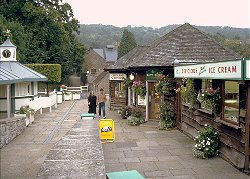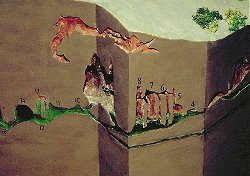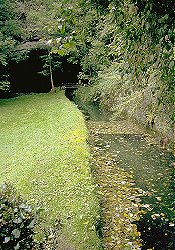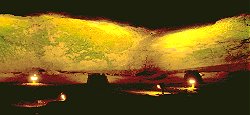Wookey Hole
Useful Information



| Location: |
The Mill, High St, Wookey Hole, Wells BA5 1BB.
Wookey Hole, near Wells. (51.226547, -2.671722) |
| Open: |
Peak Season daily 9:30-17, last entry 15:30. Off Peak daily 10-16:30, last entry 15. Peak Season is during Somerset School Holidays and at weekends. Closed 25-DEC, Boxing Day. [2024] |
| Fee: |
Adults GBP 22.95, Children (3-15) GBP 18.45, Children (0-2) free, Seniors (60+) GBP 21.95. Disabled: 50 % discount. [2024] |
| Classification: |
 Karst Cave Karst Cave
 river cave river cave
|
| Light: |
 Incandescent Incandescent
 Coloured Light Coloured Light
|
| Dimension: | L=3,890 m, VR=141 m, T=11 °C. |
| Guided tours: |
D=2 h. (includes all attractions). V=250,000/a [2019] |
| Photography: | allowed |
| Accessibility: | no |
| Bibliography: |
T.R. Shaw (1996):
Why some caves become famous - Wookey Hole, England,
Cave & Karst Science 23(1), 17-23; Bridgwater.
Duncan Price: Full Circle. WOOKEY HOLE 75 years of cave diving and exploration. Hanwell, James; Price, Duncan; Witcombe, Richard (Eds.) Cave Diving Group, Wells (2010) pp. 329-340. |
| Address: |
Wookey Hole Caves, Wookey Hole, Wells, Somerset, BA5 1BB, Tel: +44-1749-672243.
E-mail: |
| As far as we know this information was accurate when it was published (see years in brackets), but may have changed since then. Please check rates and details directly with the companies in question if you need more recent info. |
|
History
| The cave was first visited by Celts who were able to bury their dead in chamber 4. Later the water filled the link between chamber 3 and 4. | |
| 1040 | first record of a mill at Wookey. |
| 1703 | first guided tour in Wookey Hole. |
| 1857 | workmen digging the canal of the paper mill find remains of prehistoric man and the bones of animals. |
| 1912 | archaeologist Herbert Balch excavates the almost complete skeleton of an old woman. |
| 1935 | the first cave diving expedition of the world happened in Wookey Hole. |
| 1948 | Chamber 8-9 and in a second expedition chamber 10-11 were discovered. |
| 1951 | mill sold to the Inveresk Paper Co. |
| ???? | installation of the first electric lighting by the electrical engineer Christopher Aloysius Carroll. |
| 2003 | owned and operated by the Cottle Family. |
| 29-SEP-2004 | John Volanthen and Rick Slanton dive 76 m deep. |
| 2015 | show cave extended by excavating a tunnel from the ninth chamber to the 20th chamber. |
Description





Wookey Hole is a river cave located at the small village of the same name near Wells. The cave is the source of the river Axe, both the cave and the spring is used by man since prehistoric times. The river was later used by a mill, then by a paper mill. The parking lot is located at one end of the village, to reach the cave it must be crossed by foot, about 10 minutes walk. The first part of the village is full of shops, kiosks, and fish and chips. Then at the paper mill, the Wookey Hole theme park starts. The cave tour is only one of numerous "rides" of this theme park, which also offers, Dinosaur Valley, King Kong, Wizards Play Barn, Toddlers Play Area, Fairy Garden, Handmade Paper, Magical Mirror Maze, Penny Arcade, Clown Museum, Pirate Play Area, and Wookey Circus. We do not review theme parks, so we will only comment on the cave and history related parts of the park.
The entrance to the Wookey Hole cave is on the right side of the valley, which means it is at the end of a gorge cut into the limestone by the river Axe. The trail from the paper mill to the cave entrance is in the middle of the park-like valley floor. The cave is entered through a dry section, the first three chambers show no sign of a cave river anymore. It flows through younger passages right below, at least most of the time. When the water level raises after very heavy rains, this part might be flooded. However, river Axe is visble in chaber 1 and 3, but from chamber 1 it flows through two sumps to the resurgence. Chamber three or Witch’s Parlour is famous for its size, a huge solution dome dissolved by the groundwater when the water level was much higher. In comparison to its rather low ceiling, the room has an extreme diameter.
The following chambers are totally different, high and narrow clefts. Starting from chamber three, artificial tunnels connect them. The natural connection of the chambers lies below and is filled completely with water, only accessible for cave divers. The last chamber is chamber 9, which is called Cathedral. The developed trail ended at chamber nine or Cathedral Cave for many years. From chamber 9 another artificial tunnel leads back to the surface near the resurgence of the Axe. In 2015 the tour was extended by the construction of 74 m long tunnel from chamber 9 to the chamber 20. This is a dead end, so it is necessary to return to chamber 9 to leave the cave.
In 2007, about 50 carvings, which were originally thought to be mason’s marks, were identified as witch-marks or witches’ marks. Scientifically called Apotropaic marks, apotropaic derives from the Greek word apotrepein which means to turn away, they were symbols to guard against evil witches during a time when there was widespread belief in witchcraft. After their discovery the 50 carvings were the largest known concentration of ritual protection marks in any cave in Britain, but after the discovery at Creswell Crags its on second place. During the 2015 extension of the tour, more protection marks were found in a shaft which has been named Witches’ Chimney as a result. Experts from Bristol University studied the markings and dated them between 1550 and 1750. The marks are shown to visitors on guided adventure tours. Located in a remote and rather inaccessible part of the cave, their existence also proves that people at that time already visited this part of the cave. There is actually a desription of the cave by William of Worcester in 1470.
Below the parish at Wookey-hole, about half a mile from Wells, there is a certain narrow entrance (into the rock) where at the beginning is an image of a man who goes by the name of the porter, and it is the duty of the people who desire to enter the hall of Woky to ask permission of the porter, and they carry in their hands torches, which are called in English ’shevys of reed-sedge,’ for the purpose of lighting up the hall.
The hall is about as large as Westminster Hall, and there hangs from the vaulted roof wonderful pendula of stone.
The passage from the entrance to the hall is about half a furlong long, and is arched with stones of plane work hanging down from the roof.
And there is a certain broad piece of water between the ’tresance’ and the hall for the distance of five stepping stones, which stepping passage is about twenty feet wide, and if a man goes beyond the stepping stones he falls into the water, which is on all sides about five or six feet deep.
There is a kitchen in a chamber near the entrance to the hall of immense breadth, and roofed in stone.
There is also a chamber called an ost, for the purpose of drying barley grain to make beer, &c., and the figure of a woman is there clad, and holding in her girdle a spinning distaff.
And thence people pass on about a hundred paces, and a man may go along it with dry feet over the stones.
And then the chamber called the parlour follows, which is a round apartment built of huge rocks, about twenty paces broad, and in the northern part of the said parlour there is what is called in English a ’holie-hole’, and in the said well, which is fairly arched over, there is abundance of the clearest water, the depth of which water no one is able to say.
Moreover, from the said Woky-hole comes forth a great torrent, which runs into the mere, near Glastonbury, for the space of two miles.
By William of Worcester in 1470 after a visit with Symon Simeon.
Quoted in Thomas Scott Holmes (1885): History of the parish and manor of Wookey, Bristol, C.T. Jefferies and Sons, Printers.
online
Today Wookey Hole is explored to chamber 25, called the Lake of Gloom. Until this point the cave is almost horizontal, going up and down, so the cave is partly water-filled and partly air-filled. But at the end of this chamber, the character of the cave changes. It starts to steadily go down. The sump is closed by gravel chokes after about 400 m and 90 m below water level. This is the deepest point of the cave, and as the water level of cave river is around 64 m a.s.l., this spot is about 26 m below sea level.
Wookey Hole lies in the same limestone ridge as the famous
 Cheddar gorge, only a few kilometers to the south.
The limestone is covered by a layer of dolomitic breccia, which is less prone to solution.
There are fewer cracks and the chemistry of dolomite is different to limestone which also makes it a little less soluble.
This difference explains many details of the cave formation.
Cheddar gorge, only a few kilometers to the south.
The limestone is covered by a layer of dolomitic breccia, which is less prone to solution.
There are fewer cracks and the chemistry of dolomite is different to limestone which also makes it a little less soluble.
This difference explains many details of the cave formation.
The cave exit is on the left side of the valley, close to the spring of the river Axe below a steep limestone cliff face. The way back is following the tree-lined canal path, a trail along the paper mill canal which was build in 1857. The water was dammed for the canal, and so the water level inside the cave raised and chambers 4 and 5 were flooded. The canal is two meters deep and flowing steadily, a huge amount of water sufficient to drive the machinery of a paper mill.
Along the trail are three small rock shelters, named Hyena Den, Badger Hole and Rhinoceros Hole. When the canal was dug, the workmen cut through the Hyena Den and its 30 cm thick sediments. The bones in the sediments were from rhinoceros, bear, mammoth and lion, animals of both warmer and colder epochs. There were also some flint tools, archaeologists believe that the cave was used by hyenas and man alternatively from 35,000 to 25,000 BC. Both used the cave for hunting, driving their prey over the cliff edge and then harvest the remains. Similar remains were later excavated from Badger Hole and Rhinoceros Hole.
The Cave Diving Museum is dedicated to the local geology and the history of cave diving. It is located in a building of the former paper mill. Numerous items, like old diving suits and caving lamps are of great interest. The concentration on cave diving is obviously because the first cave diving expedition of history happened 1935 at Wookey Hole. Penelope Powell and Graham Balcombe discovered chamber four to seven and reached a depth of 52 m. And the most exciting fact was, that one of the first cave divers was a woman! Later, in 1948, they made two more expeditions, using diving gear developed through World War II. First they discovered chamber 8 and 9 and then chamber 10 and 11. Robert Parker made the so far deepest dive in 1985 arriving a depth of 68 m. In September 2004 John Volanthen and Rick Stanton reached a depth of over 76 m setting a new record.
- See also
 Wookey Hole, text from: Tony and Anne Oldham (1972): Discovering Caves - A guide to the Show Caves of Britain.
Wookey Hole, text from: Tony and Anne Oldham (1972): Discovering Caves - A guide to the Show Caves of Britain. Member of the International Show Caves Association (ISCA)
Member of the International Show Caves Association (ISCA) Search DuckDuckGo for "Wookey Hole Caves"
Search DuckDuckGo for "Wookey Hole Caves" Google Earth Placemark
Google Earth Placemark Wookey Hole Caves - Wikipedia (visited: 27-NOV-2022)
Wookey Hole Caves - Wikipedia (visited: 27-NOV-2022) Wookey Hole Caves and Papermill, official website.
Wookey Hole Caves and Papermill, official website. Duncan Price: Full Circle, excerpt, pdf.
Duncan Price: Full Circle, excerpt, pdf.
 Index
Index Topics
Topics Hierarchical
Hierarchical Countries
Countries Maps
Maps